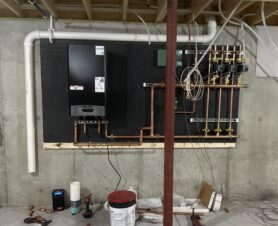Boost revenue and customer satisfaction with these installation considerations
Whether driven by rising utility costs, increased hot water demands, or environmental concerns, many homeowner customers are turning to propane tankless water heaters for a reliable, efficient water heating solution. The relatively low price and access to propane delivery services are other reasons they’ve become popular.
Propane tankless systems provide reliability and efficiency, while supplying high volumes of hot water. Because these units only need to run when hot water is needed, their gas usage must ramp up quickly when meeting high demands for hot water. As popularity of tankless systems continues to grow among customers, it’s important for you to be aware of the proper installation techniques for the gas lines that supply the tankless unit.
Help your customers get the most out of their water heater by using these five tips:
Make sure to properly size the line
When it comes to proper gas installation, manufacturers may offer varying guidance, but following the National Fuel Gas Code is the most straightforward way to ensure you’re following proper procedures.
Properly sizing the gas line is critical to ensure a customer’s tankless water heater runs at optimal efficiency. Neglecting to consider the whole system load may leave your customers with an undersized and underperforming system. Here are five factors to consider when planning for correct sizing.
- Type of gas (propane or natural gas)
- Inlet pressure
- Total length of piping run
- Type and number of gas appliances in the home
- The maximum potential gas load of the whole home
Additionally, you can download and reference the Propane Technical Pocket Guide, which provides information on how to prepare for the installation of propane systems in residential and commercial construction projects.
Consider installing one size larger gas line
Calculations aside, manufacturers like Rinnai often suggest installing larger gas lines than ones used to service tank type water heaters. It can save you from having to retrofit to a larger gas line, which can cost several hundred dollars — whereas the cost difference between running a half-inch versus a three-quarter-inch upfront is minimal.
Consider incorporating propane
Propane offers a convenient and readily available energy solution, allowing you to install gas tankless water heaters even when natural gas isn’t available. Plus, a local propane company can bury underground tanks, and, in big developments, they can put in underground piping, too, so it works just like a natural gas system.
Incorporate flex pipes
Consider using flexible gas piping — such as corrugated stainless-steel tubing (CSST) — over fixed iron pipe for running gas lines, as flex pipes can speed up and reduce the costs of your installation.
Factor gas lines into your design
In many projects, you can bypass running a gas line all the way around or through a home by installing the unit on an exterior wall or outside instead. Doing this allows for shorter gas line runs and easier venting, too.
Visit Propane.com/Water-Heating for more information about propane water heaters and installation tips.
 Bryan Cordill is director of residential and commercial business development for the Propane Education & Research Council. He can be reached at bryan.cordill@propane.com.
Bryan Cordill is director of residential and commercial business development for the Propane Education & Research Council. He can be reached at bryan.cordill@propane.com.




Join the conversation: